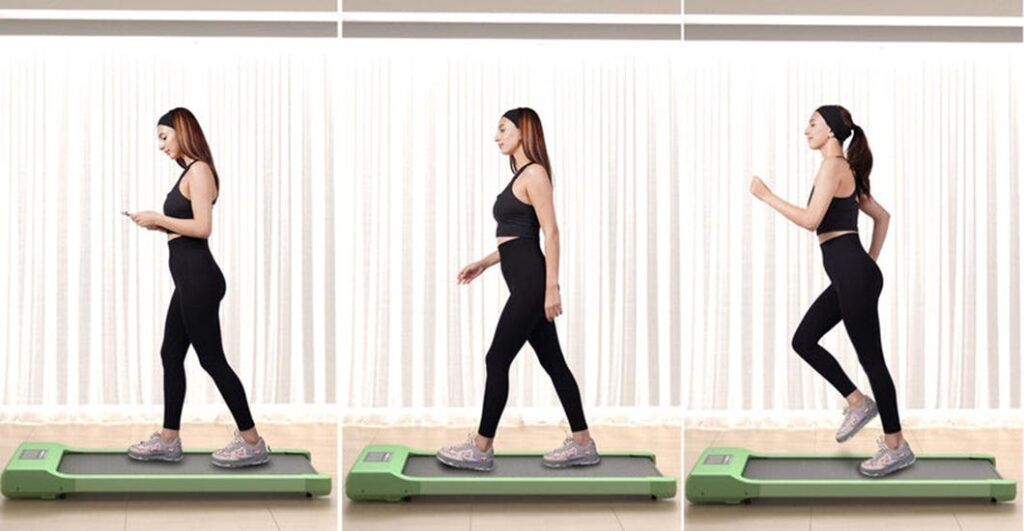walking on the treadmill every day is a common exercise routine for many individuals. But have you ever wondered if it’s actually beneficial or potentially harmful? In this article, we will explore the effects of daily treadmill walking on your overall health and provide insights into how it can contribute to your fitness goals. So, lace up your sneakers and get ready to discover the truth about walking on the treadmill every day!

Benefits of walking on the treadmill
Improved cardiovascular health
Walking on the treadmill regularly can have a positive impact on your cardiovascular health. By engaging in this low-impact form of exercise, you can strengthen your heart and improve blood circulation. This can help reduce the risk of heart disease, lower blood pressure, and cholesterol levels.
Weight loss and management
If you are looking to shed some pounds or maintain a healthy weight, walking on the treadmill can be highly effective. This activity burns calories and increases your metabolism, contributing to weight loss. By creating a calorie deficit through a combination of treadmill walking and a balanced diet, you can reach your weight loss goals and keep those extra pounds at bay.
Increased bone density
Walking on the treadmill is a weight-bearing exercise, which means it applies stress to your bones. This can help increase bone density and reduce the risk of conditions like osteoporosis. Regular treadmill walking can strengthen your bones and improve overall bone health, especially when combined with a diet rich in calcium and vitamin D.
Improved mood and mental health
Engaging in physical activity on a daily basis, such as walking on the treadmill, can do wonders for your mental well-being. Exercise releases endorphins, also known as the “feel-good” hormones, which can help boost your mood and reduce feelings of stress and anxiety. Walking on the treadmill can serve as a form of stress relief and help promote better sleep quality, leaving you feeling refreshed and rejuvenated.
Enhanced endurance and stamina
Walking on the treadmill regularly can improve your endurance and stamina over time. As you become accustomed to this exercise routine, you will notice that you can walk for longer durations without feeling as fatigued. This increase in endurance can translate to improvements in other activities and daily tasks, allowing you to tackle physical challenges with greater ease.
Risks of walking on the treadmill daily
Overuse injuries
Although walking on the treadmill is a low-impact exercise, performing it daily without proper rest and recovery can lead to overuse injuries. Issues such as shin splints, stress fractures, or tendonitis may occur due to repetitive stress on the joints and muscles. It is important to listen to your body, take rest days, and incorporate stretching and strength training exercises to prevent overuse injuries.
Muscle imbalances
Walking on the treadmill primarily targets the lower body muscles, which can lead to muscle imbalances if not balanced with other forms of exercise. Neglecting the upper body and core muscles may result in poor posture, limited mobility, and an increased risk of injuries. To prevent muscle imbalances, it is advisable to incorporate strength training exercises into your routine.
Boredom and lack of motivation
Walking on the treadmill every day can become monotonous and lead to decreased motivation to exercise. As a result, you may find it difficult to stay consistent with your routine and achieve your fitness goals. To combat boredom, try incorporating various workout styles, listening to music or podcasts, or watching TV shows or movies while walking on the treadmill. Engaging in different activities can help make your treadmill workouts more enjoyable and keep you motivated.
Reduced variety in exercises
While walking on the treadmill offers numerous benefits, it is important to remember that it primarily provides a cardiovascular workout. It may not provide the full range of benefits that a well-rounded exercise routine should have. Focusing solely on treadmill walking may limit the overall variety and diversity of exercises you engage in. It is important to consider incorporating other forms of exercise to ensure you are targeting different muscle groups and obtaining a comprehensive fitness routine.
Plateau in fitness progress
Walking on the treadmill daily can lead to a plateau in your fitness progress over time. As your body becomes accustomed to the exercise, it becomes more efficient, and the number of calories burned may decrease. To continue seeing improvements, it is crucial to challenge yourself by increasing the intensity or incorporating new exercises into your routine. By constantly pushing your limits and adding variety to your workouts, you can avoid hitting a plateau and continue progressing towards your fitness goals.
Factors to consider before daily treadmill walking
Current fitness level
Before starting a daily treadmill walking routine, it is important to assess your current fitness level. If you are just beginning your fitness journey or have been inactive for a while, it is recommended to start slowly and gradually increase the intensity and duration of your treadmill sessions. Consulting with a healthcare professional or fitness trainer can help determine an appropriate starting point for your fitness level.
Existing health conditions
If you have any pre-existing health conditions, it is essential to consider them before committing to daily treadmill walking. Some conditions may require modifications to your exercise routine or additional precautions. Consulting with a healthcare professional can provide valuable guidance on whether treadmill walking is suitable for you and how to proceed safely.
Age and body weight
Age and body weight can play a role in determining the intensity and duration of treadmill walking. Older individuals or those with excess body weight may need to start with shorter sessions and lower intensities to minimize strain on the joints. Gradually increasing the intensity and duration over time, while keeping in mind any limitations, can help prevent injuries and maximize the benefits of treadmill walking.
Time availability
Daily treadmill walking requires a time commitment, so it is important to consider your availability and schedule. Determine how much time you can allocate to treadmill walking each day and plan your routine accordingly. If finding a dedicated block of time is challenging, consider breaking your workouts into shorter sessions throughout the day.
Personal preferences
Personal preferences also play a significant role in the sustainability of any exercise routine. If you enjoy walking on the treadmill and find it convenient, it can be a great option for daily exercise. However, if you dislike the treadmill or prefer other forms of exercise, it may be more beneficial to explore alternative options that align with your preferences. The key is finding an exercise routine that you enjoy and will stick to in the long run.
Recommended duration and intensity
Setting achievable goals
Before beginning your daily treadmill walking routine, it is important to set achievable goals. Whether you are aiming for weight loss, improved cardiovascular fitness, or overall health, establish specific and measurable targets. This will help you stay motivated and track your progress along the way.
Starting slow and gradually increasing
When starting a daily treadmill walking routine, it is essential to start slow and gradually increase the intensity and duration of your workouts. Begin with a comfortable pace and duration that you can maintain without excessive fatigue or discomfort. As your fitness level improves, gradually increase the speed, incline, or duration of your treadmill walks. This progressive approach will help prevent overuse injuries and allow your body to adapt to the increased demands.
The importance of warm-up and cool-down
Before each treadmill session, make sure to include a proper warm-up and cool-down. A warm-up prepares your body for exercise by increasing blood flow, raising body temperature, and loosening up the muscles. This can be done through a few minutes of light stretching or dynamic movements. Cooling down after your workout helps bring your heart rate and body temperature back to normal gradually. It also allows for a smooth recovery and reduces muscle soreness.
Listening to your body’s signals
Your body is the best indicator of when to adjust the duration and intensity of your treadmill walks. It is crucial to listen to your body’s signals and respond accordingly. If you experience excessive fatigue, muscle soreness, or any discomfort, it may be a sign to lower the intensity or take a rest day. Pushing through pain can lead to injuries and hinder your progress. Always prioritize safety and give your body the recovery time it needs.
Monitoring heart rate
Monitoring your heart rate during treadmill walking can help gauge the intensity of your workouts. Aim for a heart rate that corresponds to your target heart rate zone, which is generally around 50-85% of your maximum heart rate. You can calculate this zone using various formulas or utilize fitness trackers or heart rate monitors to track your heart rate during exercise. Monitoring your heart rate can guide you in adjusting the speed or incline of the treadmill to ensure you are exercising within the desired range.

Tips for making daily treadmill walking effective
Incorporating incline variations
To make your daily treadmill walking more effective, consider incorporating incline variations. Walking on an incline can increase the intensity of your workout, engage different muscle groups, and burn more calories. Gradually increase the incline to challenge yourself and simulate outdoor walking or hiking. Incline variations can add variety to your routine and help you avoid plateaus in your fitness progress.
Adding resistance training
While walking on the treadmill primarily focuses on cardiovascular fitness, incorporating resistance training can enhance the overall effectiveness of your workouts. Consider adding exercises such as lunges, squats, or using resistance bands while walking. This can engage the muscles of the lower body and increase calorie burn. Including resistance training exercises every few minutes or on alternate days can help create a balanced workout routine.
Interval training for intensity
Interval training involves alternating between periods of high-intensity exercise and short recovery periods. This form of training can be particularly effective for treadmill walking. Incorporate intervals of increased speed or incline to challenge yourself and boost cardiovascular fitness. For example, alternate between a brisk walk and a faster-paced walk or incorporate short bursts of jogging or running. Interval training can elevate your heart rate, increase calorie burn, and improve overall fitness.
Mixing different walking styles
To make your daily treadmill walking more interesting and engaging, experiment with different walking styles. Try walking at different speeds, incorporating lateral or side steps, or engaging your arms by actively swinging them while walking. These variations can target different muscle groups and add a fun factor to your treadmill workouts. Additionally, these movements can improve balance, coordination, and core stability.
Utilizing technology and apps
Take advantage of technology and various apps available to enhance your treadmill walking experience. Fitness apps can help track your progress, provide guided workouts, and offer motivation and challenges. Some apps even provide virtual outdoor walking experiences, enabling you to explore different scenic routes from the comfort of your home. Utilizing technology can make your treadmill walking more enjoyable and help you stay on track with your fitness goals.
Alternatives to daily treadmill walking
Outdoor walking or hiking
If you prefer the outdoors and want to enjoy nature, outdoor walking or hiking can be a great alternative to treadmill walking. Walking in a natural environment can provide fresh air, varied terrain, and a change of scenery. It can also challenge your body in different ways and offer additional mental and emotional benefits. Just make sure to choose appropriate trails suitable for your fitness level and follow safety guidelines.
Running or jogging
For those seeking a higher-intensity cardiovascular workout, running or jogging can be an alternative to treadmill walking. Running or jogging involves a faster pace and higher impact, providing a greater calorie burn and further cardiovascular conditioning. However, it is important to start gradually and ensure proper running form to avoid injuries. Building up endurance and incorporating intervals can help improve running performance.
Group fitness classes
If you thrive on social interaction and prefer exercising with others, group fitness classes can be an excellent alternative to individual treadmill walking. Many fitness centers offer classes that incorporate walking or other forms of aerobic exercise, providing a supportive and motivating environment. Group fitness classes can offer variety, guidance from an instructor, and the opportunity to meet like-minded individuals.
Cycling or swimming
If you are looking for low-impact alternatives to treadmill walking, consider cycling or swimming. Cycling can challenge your cardiovascular system and engage different muscle groups while putting minimal stress on the joints. Swimming is also low-impact and offers a full-body workout, incorporating both cardiovascular fitness and strength building. Both activities can provide a refreshing change from treadmill walking and help prevent overuse injuries.
Aerobic dance or Zumba
For those who enjoy dancing and want to combine fitness with fun, aerobic dance or Zumba classes can be an exciting alternative to treadmill walking. These dance-based workouts can elevate your heart rate, improve coordination, and provide a full-body workout. The energizing music and lively atmosphere can make exercise feel more like a social event rather than a chore. Consider joining a dance fitness class in your area to explore this alternative.

Professional recommendations
Consulting with a healthcare professional or fitness trainer
Before starting any exercise routine, it is advisable to consult with a healthcare professional or certified fitness trainer. They can assess your overall health, provide personalized recommendations, and ensure that treadmill walking is suitable for your specific circumstances. They can also help design a workout plan tailored to your goals, fitness level, and any existing health conditions.
Following personalized exercise plans
After consulting with a professional, following a personalized exercise plan can optimize the effectiveness and safety of your daily treadmill walking routine. They can guide you on the appropriate intensity, duration, and frequency of your workouts based on your individual needs and goals. A personalized plan takes into account your current fitness level, available time, and any limitations you may have.
Considering individual limitations and goals
An important aspect of any exercise routine is considering individual limitations and goals. Everyone’s body is unique, and certain restrictions or goals may need to be taken into account. Factors such as past injuries, joint issues, or specific fitness objectives should be considered when determining the duration and intensity of treadmill walking. A healthcare professional or fitness trainer can help modify your workouts accordingly.
Seeking guidance for proper form and technique
To ensure safety and maximize the benefits of treadmill walking, it is essential to maintain proper form and technique. Seek guidance from a fitness professional to learn the correct posture, foot strike, and arm movement during treadmill walking. They can help you avoid common mistakes and prevent injuries. Improper form and technique may lead to muscle imbalances or strain on the joints.
Regular health check-ups
Regular health check-ups are crucial when engaging in daily treadmill walking or any form of exercise. They provide an opportunity to monitor your overall health, assess your progress, and address any concerns or potential issues. Regular check-ups can help catch any underlying health problems or ensure that your exercise routine aligns with your changing health needs over time.
Signs to watch out for
Excessive fatigue or muscle soreness
Feeling excessively tired or experiencing prolonged muscle soreness after daily treadmill walking may indicate that you are pushing your body too hard. While some fatigue and soreness are normal, they should not persist for an extended period or significantly impact your daily activities. It is important to adjust the intensity and duration of your treadmill walks or consider taking rest days as needed.
Persistent pain or discomfort
Persistent pain or discomfort, especially in joints, muscles, or ligaments, should not be ignored. It may indicate an underlying injury or overuse issue. If you experience any pain or discomfort that persists beyond a few days, it is important to seek medical attention. Ignoring or pushing through pain can lead to further damage and hinder your progress.
Shortness of breath or dizziness
Feeling excessively short of breath or experiencing dizziness during treadmill walking can be a cause for concern. It may indicate that you are pushing yourself too hard or that there is an underlying cardiovascular issue. If you experience these symptoms, it is crucial to stop exercising, rest, and consult with a healthcare professional to determine the cause and appropriate course of action.
Abnormal heart rate or blood pressure
Monitoring your heart rate and blood pressure during treadmill walking is important for assessing your cardiovascular fitness and ensuring your safety. If you notice any abnormal or irregular changes in your heart rate or blood pressure, it is essential to consult with a healthcare professional. They can help determine if further evaluation is needed and provide guidance on managing your condition during exercise.
Mental or emotional burnout
Engaging in daily treadmill walking can have mental and emotional benefits. However, it is important to watch out for signs of mental or emotional burnout. Feeling excessively stressed, demotivated, or overwhelmed by your exercise routine may indicate that you need to reassess and make adjustments. It is important to prioritize your mental and emotional well-being and seek support if needed.

Creating a balanced exercise routine
Incorporating strength training
To create a balanced exercise routine, it is important to incorporate strength training exercises in addition to daily treadmill walking. Strength training helps build muscle, increase metabolism, and improve overall body composition. Include exercises that target major muscle groups, such as squats, lunges, push-ups, and planks. Aim for two to three strength training sessions per week, alternating between different muscle groups.
Including flexibility and stretching exercises
Flexibility and stretching exercises are important components of a well-rounded exercise routine. They help improve joint mobility, prevent muscle imbalances, and reduce the risk of injuries. Include dynamic stretches before your treadmill walks to warm up your muscles, and static stretches afterwards to improve flexibility and aid in recovery. Yoga or Pilates classes can also be beneficial for overall flexibility and relaxation.
Engaging in aerobic and anaerobic activities
In addition to daily treadmill walking, engaging in both aerobic and anaerobic activities can provide a balanced workout routine. Aerobic activities, such as swimming, cycling, or dancing, help improve cardiovascular fitness and endurance. Anaerobic activities, such as weightlifting or high-intensity interval training (HIIT), focus on building strength and power. Combining both types of exercise can enhance overall fitness and prevent exercise plateaus.
Balancing cardio with rest and recovery
While daily treadmill walking can be beneficial, it is important to balance it with rest and recovery. Giving your body time to recover allows for muscle repair and adaptation. Incorporate rest days throughout the week and alternate between different forms of exercise to prevent overuse injuries and mental burnout. Listen to your body and adjust your exercise routine accordingly.
Trying different types of workouts
Adding variety to your exercise routine is key to staying motivated and preventing boredom. In addition to daily treadmill walking, try incorporating different types of workouts, such as dance classes, yoga, swimming, or cycling. Experimenting with various activities challenges different muscle groups, keeps your workouts exciting, and helps you discover new interests. Embrace variety and find what works best for you.
Conclusion
Walking on the treadmill every day can offer numerous benefits for your physical and mental well-being. Improved cardiovascular health, weight loss, increased bone density, improved mood, and enhanced endurance are just a few of the advantages. However, it is important to be aware of the potential risks, such as overuse injuries, muscle imbalances, boredom, and plateaus in fitness progress.
Before starting a daily treadmill walking routine, consider factors such as your current fitness level, existing health conditions, age, body weight, time availability, and personal preferences. It is also important to follow recommended guidelines, set achievable goals, and pay attention to your body’s signals. Incorporating incline variations, resistance training, interval training, different walking styles, and utilizing technology can make your daily treadmill walking more effective and enjoyable.
If treadmill walking is not your preferred form of exercise, there are various alternatives to consider, such as outdoor walking or hiking, running or jogging, group fitness classes, cycling or swimming, and aerobic dance or Zumba. It is crucial to consult with a healthcare professional or fitness trainer, follow personalized exercise plans, and prioritize safety.
Watching out for signs such as excessive fatigue, persistent pain, shortness of breath, abnormal heart rate or blood pressure, and mental or emotional burnout is essential for maintaining a healthy exercise routine. Creating a balanced exercise routine that includes strength training, flexibility exercises, aerobic and anaerobic activities, and proper rest and recovery is crucial.
In conclusion, walking on the treadmill every day can be beneficial, but it is important to be mindful of the risks, consider personal factors and preferences, and combine it with other forms of exercise for a holistic fitness routine. Listen to your body, seek professional advice when needed, and embrace variety to enjoy the journey towards a healthier and happier lifestyle.







